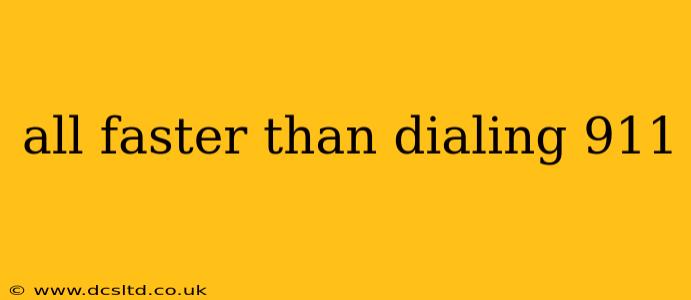Faster Than Dialing 911: Exploring Emergency Response Innovations
In a crisis, seconds count. The familiar urgency of dialing 911 is ingrained in us, but what if emergency response could be even faster? This article explores the cutting-edge technologies and strategies aiming to drastically reduce response times, potentially saving lives in the process. We'll delve into existing and emerging solutions, addressing common questions surrounding this critical area of public safety.
What are some technologies that could get emergency responders to a scene faster than a 911 call?
Several technological advancements are striving to accelerate emergency response, moving beyond the limitations of a traditional 911 call. These include:
-
Smartwatches and Wearables: Many smartwatches now have fall detection and emergency SOS features. These automatically alert emergency services and provide location data, often even before the wearer can consciously make a call. This bypasses the time spent dialing and explaining the situation.
-
Predictive Policing and AI: Advanced algorithms analyze crime data and other relevant information to identify high-risk areas and predict potential emergencies. This allows for proactive deployment of resources, potentially reaching a scene even before an incident is officially reported.
-
Drone Technology: Drones equipped with cameras and sensors can be deployed rapidly to assess situations, providing real-time visual information to emergency responders. This allows for quicker decision-making and a more efficient allocation of resources. They can also deliver essential medical supplies in situations where time is critical.
-
Automated External Defibrillators (AEDs): Increased accessibility to AEDs, coupled with training programs, empowers bystanders to provide life-saving interventions before professional help arrives. Every second counts in cardiac arrest, and this immediate action can greatly improve survival rates.
-
Improved Communication Systems: Enhanced communication networks and dispatch systems streamline the process of receiving and responding to emergency calls, minimizing delays and ensuring clear communication between dispatchers, first responders, and medical professionals.
How accurate is location data in emergency situations?
The accuracy of location data is crucial for effective emergency response. While GPS technology is generally reliable, there are factors that can affect accuracy:
-
Indoor Locations: GPS signals can be weak or unavailable indoors, hindering precise location determination. Solutions like Wi-Fi positioning and Bluetooth beacons are being developed to overcome this limitation.
-
Signal Interference: Obstacles like buildings, dense foliage, or atmospheric conditions can interfere with GPS signals, reducing accuracy.
-
User Error: In a panic, a person may provide inaccurate location information, further complicating response efforts.
Efforts to improve location accuracy include the development of more sophisticated positioning technologies, as well as user-friendly interfaces that minimize the chance of errors during emergency calls.
Are there any apps that can help emergency responders get to a scene faster?
While no single app guarantees faster response times universally, several apps contribute to improved emergency communication and information sharing:
-
Emergency alert apps: Many jurisdictions utilize apps to disseminate emergency alerts and notifications to the public, allowing for quick dissemination of critical information.
-
Citizen reporting apps: Some apps allow citizens to directly report incidents with photos and videos, providing crucial context to emergency responders.
-
Medical alert apps: These apps can share important medical information with first responders, ensuring they have the necessary information to provide appropriate care.
It's important to note that app effectiveness depends on factors such as network connectivity and app features.
What role does technology play in improving pre-hospital care?
Technology is revolutionizing pre-hospital care, dramatically impacting the speed and quality of medical assistance. This includes:
-
Telemedicine: Real-time video conferencing allows medical professionals to remotely assess patients and provide guidance to first responders, ensuring that appropriate treatment is initiated promptly.
-
Wearable Sensors: Sensors monitoring vital signs can provide real-time data to emergency medical services, enabling them to make more informed decisions about the level of care required.
-
Remote Diagnostics: Advancements in remote diagnostics allow for rapid assessment of critical parameters, aiding in quicker and more accurate diagnosis even before reaching the hospital.
The future of emergency response is undeniably linked to technological innovation. The focus on speed and efficiency isn't simply about faster response times—it's about saving lives and improving outcomes in critical situations. While challenges remain, the advancements discussed here offer a promising glimpse into a future where emergency assistance is even more readily available and effective.
